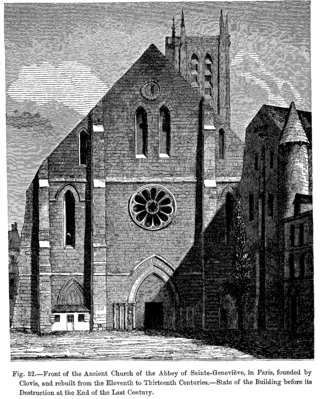Related Research Articles

The pipe organ is a musical instrument that produces sound by driving pressurised air through the organ pipes selected from a keyboard. Because each pipe produces a single pitch, the pipes are provided in sets called ranks, each of which has a common timbre, volume, and construction throughout the keyboard compass. Most organs have many ranks of pipes of differing pitch, timbre, and volume that the player can employ singly or in combination through the use of controls called stops.

Jean (Jehan) Titelouze was a French Catholic priest, composer, poet and organist of the late Renaissance and early Baroque periods. He was a canon and organist at Rouen Cathedral. His style was firmly rooted in the Renaissance vocal tradition and as such, was far removed from the distinctly French style of organ music that developed during the mid-17th century. However, his hymns and Magnificat settings are the earliest known published French organ collections, and he is regarded as the first composer of the French organ school.

Nicolas de Grigny was a French organist and composer. He died young and left behind a single collection of organ music, and an Ouverture for harpsichord.

Antonio de Cabezón was a Spanish Renaissance composer and organist. Blind from childhood, he quickly rose to prominence as a performer and was eventually employed by the royal family. He was among the most important composers of his time and the first major Iberian keyboard composer.

Charles Racquet (1597–1664) was a French organist and composer, best known for his monumental organ Fantaisie.
Franz Tunder was a German composer and organist of the early to middle Baroque era. He was an important link between the early German Baroque style which was based on Venetian models, and the later Baroque style which culminated in the music of J.S. Bach; in addition he was formative in the development of the chorale cantata.
The organ repertoire is considered to be the largest and oldest repertory of all musical instruments. Because of the organ's prominence in worship in Western Europe from the Middle Ages on, a significant portion of organ repertoire is sacred in nature. The organ's suitability for improvisation by a single performer is well adapted to this liturgical role and has allowed many blind organists to achieve fame; it also accounts for the relatively late emergence of written compositions for the instrument in the Renaissance. Although instruments are still disallowed in most Eastern churches, organs have found their way into a few synagogues as well as secular venues where organ recitals take place.

The French Organ Mass is a type of Low Mass that came into use during the Baroque era. Essentially it is a Low Mass with organ music playing throughout: part of the so-called alternatim practice.

André Raison was a French Baroque composer and organist. During his lifetime he was one of the most famous French organists and an important influence on French organ music. He published two collections of organ works, in 1688 and 1714. The first contains liturgical music intended for monasteries and a preface with information on contemporary performance practice. The second contains mostly noëls.
André Edouard Antoine Marie Fleury was a French composer, pianist, organist, and pedagogue.
George C. Baker is an American organist, composer, pedagogue, and dermatologist.
Manuel Rodrigues Coelho was a Portuguese organist and composer. He is the first important Iberian keyboard composer since Cabezón.
Juan Bautista José Cabanilles was a Spanish organist and composer at Valencia Cathedral. He is considered by many to have been the greatest Spanish Baroque composer, and has been called the Spanish Bach.
Sebastian Anton Scherer was a German composer and organist of the Baroque era.
Alternatim refers to a technique of liturgical musical performance, especially in relationship to the Organ Mass, but also to the Hymns, Magnificat and Salve regina traditionally incorporated into the Vespers and other liturgies of the Catholic Church. A specific part of the ordinary of the Mass would be divided into versets. Each verset would be performed antiphonally by two groups of singers, giving rise to polyphonic settings of half of the text. One of these groups may alternatively have consisted of a soloist, a group of instruments, or organ. The missing even- or odd-numbered verses were supplied by plainchant or, perhaps more commonly, by improvisations on the organ. The verso became a particularly prevalent genre in Renaissance and Baroque organ music, both Italian and Iberian, and most of the French classical organ literature consists of alternatim versets.
Verso is the left-hand page of a folded sheet or bound item, such as a book, broadsheet, or pamphlet.
Marc-Antoine Charpentier composed six Te Deum settings, but only four of them have survived. Largely because of the great popularity of its prelude, the best known is the Te Deum in D major, H.146, written as a grand motet for soloists, choir, and instrumental accompaniment probably between 1688 and 1698, during Charpentier's stay at the Jesuit Church of Saint-Louis in Paris, where he held the position of musical director.

Thierry Joseph-Louis Escaich is a French organist and composer.

Jean-Baptiste Robin is a French composer and organist.

The Verset pour la fête de la Dédicace is a short composition for organ by French composer Olivier Messiaen. It was completed in 1960.
References
- ↑ John R. Shannon -The Evolution of Organ Music in the 17th Century 0786488662 2012 - Page 282 "Verset (also verso): In the practice of alternation, a short section of music designed to substitute for a single passage of . "